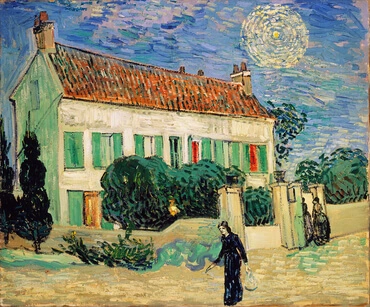House

A "house" is essentially a container -- for a person, a family, several families or even a large group with shared interests (think of the term "houses of worship.") In the Bible, a "house" is also a container, but for spiritual things rather than natural things. In various uses a "house" can represent part of the mind, the whole mind, a whole person or even a church. The other nuance to the word "house" is that it is generally used in regards to our affections and desires rather than our thoughts and principles. This makes sense; we tend to engage our thoughts and rationality when we are out in the world doing our work, but when we are inside our houses we are driven most by love for our families and the desire to be good to those we love. So "house" tends to represent the things we want and care about -- which are ultimately the things that define us.
Apocalypse Revealed # 242
242. The second living creature like a calf. This symbolizes the Divine truth of the Word in respect to its affection.
Beasts of the earth symbolize various natural affections. They are also embodiments of them. And a calf symbolizes an affection for knowing. This affection is represented by a calf in the spiritual world, and in the Word it is consequently also symbolized by a calf, as in Hosea,
...we repay (to Jehovah) the calves of our lips. (Hosea 14:2)
"Calves of the lips" are confessions from an affection for truth.
In Malachi:
To you who fear My name the sun of righteousness shall arise with healing in its wings... that you may grow fat like fattened calves. (Malachi 4:2)
A comparison is made with fattened calves because they symbolize people who are filled with concepts of truth and goodness owing to an affection for knowing them.
In the book of Psalms:
The voice of Jehovah... makes (the cedars of Lebanon) dance like a calf... (Psalms 29:5, 6)
The cedars of Lebanon symbolize concepts of truth. That is why the passage says that the voice of Jehovah makes them dance like a calf. The voice of Jehovah is Divine truth, in the process here of affecting.
[2] Since the Egyptians loved knowledge, they therefore made themselves calves as a sign of their affection for it. But after they began to worship the calves as deities, then calves in the Word symbolized affections for knowing falsities, as in Jeremiah 46:20-21). Therefore we are told in Hosea:
...they have made for themselves a molten image... of their silver... Sacrificing a human being, they kiss the calves. (Hosea 13:2)
To make for oneself a molten image of silver means, symbolically, to falsify truth. To sacrifice a human being means, symbolically, to destroy wisdom. And to kiss calves means, symbolically, to accept falsities out of an affection for them.
In Isaiah:
There the calf will feed; there it will lie down and consume its branches. (Isaiah 27:10)
The same is symbolically meant by the calf in Jeremiah 34:18-20.
[3] Since all Divine worship springs from affections for truth and goodness and so for concepts of them, therefore the sacrifices in which the worship of the church primarily consisted among the children of Israel used various animals, such as lambs, she-goats, kids, sheep, he-goats, calves, and oxen; and calves were used because they symbolized an affection for knowing truths and goods, which is the first natural affection. This affection was symbolically meant by the sacrifices of calves in Exodus 29:11-12, 1 1 Samuel 1:25; 16:2, 1 Kings 18:23-26, 33.
The second living creature looked like a calf because the Divine truth of the Word, which it symbolizes, affects hearts, and so teaches and instills.
Poznámky pod čarou:
1. Prima editio: 29.






